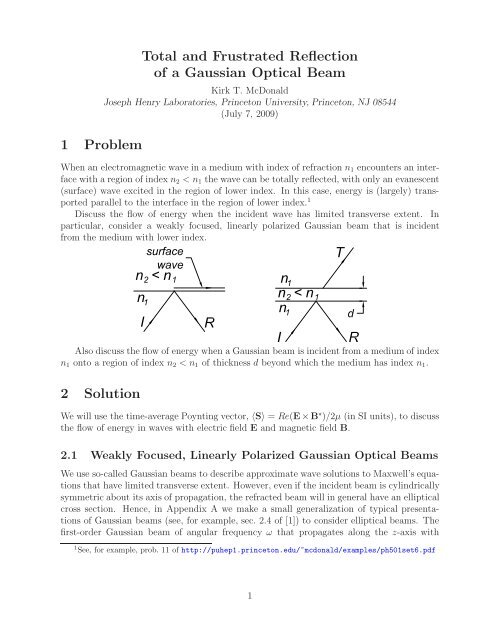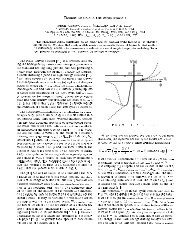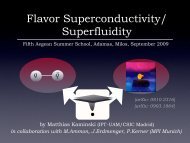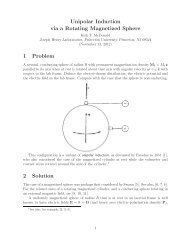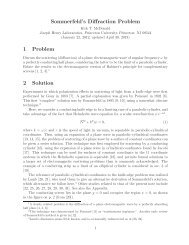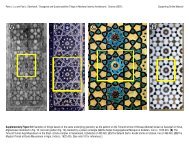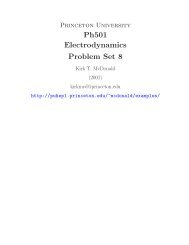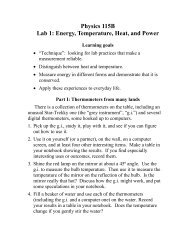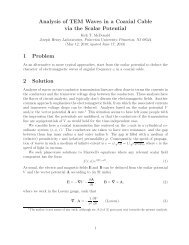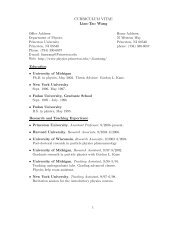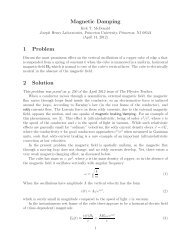Total and Frustrated Reflection of a Gaussian Optical Beam 1 ...
Total and Frustrated Reflection of a Gaussian Optical Beam 1 ...
Total and Frustrated Reflection of a Gaussian Optical Beam 1 ...
You also want an ePaper? Increase the reach of your titles
YUMPU automatically turns print PDFs into web optimized ePapers that Google loves.
1 Problem<br />
<strong>Total</strong> <strong>and</strong> <strong>Frustrated</strong> <strong>Reflection</strong><br />
<strong>of</strong> a <strong>Gaussian</strong> <strong>Optical</strong> <strong>Beam</strong><br />
Kirk T. McDonald<br />
Joseph Henry Laboratories, Princeton University, Princeton, NJ 08544<br />
(July 7, 2009)<br />
When an electromagnetic wave in a medium with index <strong>of</strong> refraction n 1 encounters an interface<br />
with a region <strong>of</strong> index n 2
y-polarization in a medium with permittivity ɛ <strong>and</strong> permeability μ has fields<br />
E x ≈ 0,<br />
E y ≈ E 0 e −ρ2 /(1+z 2 /z0 2)<br />
√ e i{kz[1+z 0ρ 2 /k(z 2 +z0 2)]−ωt−tan−1 (z/z 0 )} , (1)<br />
1+z 2 /z0<br />
2<br />
E z ≈ − 2iy e −i tan−1 z/z 0<br />
E<br />
kw0y<br />
2 y √ ,<br />
1+z 2 /z0<br />
2<br />
B x = − n c E y, B y =0, B z = 2ix n<br />
kw0x<br />
2<br />
where c is the speed <strong>of</strong> light in vacuum,<br />
c E y<br />
k 0 = ω c , k = nk 0, n = c √ √<br />
ɛμ, ρ =<br />
e −i tan−1 z/z 0<br />
√<br />
1+z 2 /z 2 0<br />
√ x2<br />
w 2 0x<br />
, (2)<br />
+ y2<br />
, (3)<br />
w0y<br />
2<br />
w 0j for j = x or y is the characteristic radius <strong>of</strong> the beam at its waist (focus), θ 0j is the<br />
diffraction angle <strong>and</strong> z 0 is the Rayleigh range, as shown in the figure below, which are related<br />
by<br />
θ 0j = w 0j<br />
z 0<br />
,<br />
1<br />
= 1 + 1<br />
z 0 kw0x<br />
2 kw0y<br />
2<br />
(<br />
z 0 = kw2 0<br />
2 = 2<br />
kθ 2 0<br />
)<br />
if w 0x = w 0y = w 0 . (4)<br />
Near the focus (ρ < ∼ 1, |z|
equations provided w 0j ≪ z 0 , i.e., θ 0j ≪ 1. This is the case in the present problem, where<br />
we wish to explore the behavior <strong>of</strong> very weakly focused optical beams.<br />
The flow <strong>of</strong> energy in this elliptical beam is described by the (real) Poynting vector,<br />
S =<br />
ReE × ReB<br />
μ<br />
√ (<br />
ɛ<br />
=<br />
μ E2 0 e−2ρ2<br />
− 2x sin[2(kz − ωt)], − 2y sin[2(kz − ωt)], cos 2 (kz − ωt)<br />
kw0x<br />
2 kw0y<br />
2<br />
(7)<br />
The time-average flow <strong>of</strong> energy is, <strong>of</strong> course, only in the direction <strong>of</strong> propagation <strong>of</strong> the<br />
wave. In addition, there is an oscillatory transverse flow <strong>of</strong> energy. 3<br />
2.2 <strong>Reflection</strong> <strong>and</strong> Refraction at a Single Interface<br />
The classic formalism for plane waves is reviewed in Appendix B.<br />
We first consider the refraction <strong>of</strong> a weakly focused <strong>Gaussian</strong> beam at a single interface<br />
between linear, isotropic media <strong>of</strong> indices n 1 = c √ ɛ 1 μ 1 <strong>and</strong> n 2 = c √ ɛ 2 μ 2 , using notation<br />
as shown in the figure below. For simplicity, we restrict our attention to the case that the<br />
electric field is perpendicular to the plane <strong>of</strong> incidence (i.e., tothex-z plane).<br />
)<br />
.<br />
The incident, reflected <strong>and</strong> transmitted beams each have the <strong>Gaussian</strong> form (5)-(6), with<br />
respect to axes (x i ,y i ,z i ), (x r ,y r ,z r )<strong>and</strong>(x t ,y t ,z t ), where the z-axes are in the directions <strong>of</strong><br />
propagation <strong>of</strong> the various beams.<br />
The transformation between the axes (x i ,y i ,z i ) <strong>of</strong> the incident beam <strong>and</strong> the laboratory<br />
axes (x, y, z) is<br />
<strong>and</strong><br />
x i =cosθ 1 x − sin θ 1 z, y i = y, z i =sinθ 1 x +cosθ 1 z, (8)<br />
ρ 2 i = x2 i<br />
+ y2 i<br />
wix<br />
2 wiy<br />
2<br />
= cos2 θ 1 x 2 − sin 2θ 1 xz +sin 2 θ 1 z 2<br />
w 2 ix<br />
+ y2<br />
, (9)<br />
wiy<br />
2<br />
where θ 1 is the angle between the axis <strong>of</strong> the incident beam <strong>and</strong> the z-axis, <strong>and</strong> we assume<br />
that axis <strong>of</strong> the incident beam passes through the origin. The components <strong>of</strong> a vector A<br />
with respect to the laboratory frame are related to those with respect to axes (x i ,y i ,z i )by<br />
A x =cosθ 1 A xi +sinθ 1 A zi , A y = A yi , A z = − sin θ 1 A xi +cosθ 1 A zi . (10)<br />
3 Near its waist, a <strong>Gaussian</strong> beam is similar to a wave inside a conducting wave guide, which latter case<br />
also exhibits steady longitudinal, <strong>and</strong> oscillatory transverse, flow <strong>of</strong> energy [2].<br />
3
Combining eqs. (5)-(10), the components <strong>of</strong> the incident beam in the laboratory frame are<br />
E ix = −i sin θ 1 y<br />
z 0<br />
E iy , (11)<br />
E iy = E 0i e −ρ2 i e<br />
i(n 1 sin θ 1 k 0 x+n 1 cos θ 1 k 0 z−ωt) , (12)<br />
E iz = −i cos θ 1 y<br />
E iy , (13)<br />
z 0<br />
B ix = n [<br />
]<br />
1<br />
cos θ 1 x − sin θ 1 z<br />
cos θ 1 − i sin θ 1 E iy , (14)<br />
c<br />
z 0<br />
B iy = 0 (15)<br />
B iz = n [<br />
]<br />
1<br />
cos θ 1 x − sin θ 1 z<br />
sin θ 1 + i cos θ 1 E iy . (16)<br />
c<br />
z 0<br />
Similarly, the reflected beam is related by<br />
x r = − cos θ 1 x − sin θ 1 z, y r = y, z r = − sin θ 1 x − cos θ 1 z, (17)<br />
ρ 2 r = x2 r<br />
+ y2 r<br />
wrx<br />
2 wrx<br />
2<br />
= cos2 θ 1 x 2 +sin2θ 1 xz +sin 2 θ 1 z 2<br />
w 2 rx<br />
+ y2<br />
,, (18)<br />
wrx<br />
2<br />
A x = − cos θ 1 A xi +sinθ 1 A zi , A y = A yi , A z = − sin θ 1 A xi − cos θ 1 A zi , (19)<br />
E rx = −i sin θ 1 y<br />
E ry ,<br />
z 0<br />
(20)<br />
E ry = E 0r e −ρ2 r e<br />
i(n 1 sin θ 1 k 0 x−n 1 cos θ 1 k 0 z−ωt) , (21)<br />
E rz = i cos θ 1 y<br />
E iy ,<br />
z 0<br />
(22)<br />
B rx = n [<br />
]<br />
1<br />
cos θ 1 x +sinθ 1 z<br />
− cos θ 1 + i sin θ 1 E ry ,<br />
c<br />
z 0<br />
(23)<br />
B ry = 0 (24)<br />
B rz = n [<br />
]<br />
1<br />
cos θ 1 x +sinθ 1 z<br />
sin θ 1 + i cos θ 1 E ry ,<br />
c<br />
z 0<br />
(25)<br />
where we have assumed that the reflected beam also makes angle θ 1 with respect to the<br />
z-axis, <strong>and</strong> that the axis <strong>of</strong> the reflected beam passes through the origin.<br />
Likewise, the transmitted beam is related by<br />
x t =cosθ 2 x − sin θ 2 z, y t = y, z t =sinθ 2 x +cosθ 2 z, (26)<br />
ρ 2 t = x2 t<br />
+ y2 t<br />
wtx<br />
2 wty<br />
2<br />
= cos2 θ 2 x 2 − sin 2θ 2 xz +sin 2 θ 2 z 2<br />
w 2 tx<br />
+ y2<br />
, (27)<br />
wty<br />
2<br />
A x =cosθ 2 A xt +sinθ 2 A zt , A y = A yt , A z = − sin θ 2 A xt +cosθ 2 A zt , (28)<br />
4
E tx = −i sin θ 2 y<br />
E ty ,<br />
z 0t<br />
(29)<br />
E ty = E 0t e −ρ2 t e<br />
i(n 2 sin θ 2 k 0 x+n 2 cos θ 2 k 0 z−ωt) , (30)<br />
E tz = −i cos θ 2 y<br />
E ty ,<br />
z 0t<br />
(31)<br />
B tx = n 2<br />
c<br />
B tz = n 2<br />
c<br />
[<br />
]<br />
cos θ 2 x − sin θ 2 z<br />
cos θ 2 − i sin θ 2 E ty ,<br />
z 0t<br />
(32)<br />
B ty = 0 (33)<br />
[<br />
]<br />
cos θ 2 x − sin θ 2 z<br />
sin θ 2 + i cos θ 2 E ty .<br />
z 0t<br />
(34)<br />
The boundary conditions at the interface z =0arethatE ⊥ , D z = ɛE z , B z <strong>and</strong> H ⊥ =<br />
B ⊥ /μ are continuous. Thus, continuity <strong>of</strong> E y<br />
E 0i e −ρ2 i e<br />
i(n 1 sin θ 1 k 0 x−ωt) + E 0r e −ρ2 r e<br />
i(n 1 sin θ 1 k 0 x−ωt) = E 0t e −ρ2 t e<br />
i(n 2 sin θ 2 k 0 x−ωt) , (35)<br />
for all x <strong>and</strong> y, which confirms the assumption that θ r = θ i = θ i , verifies Snell’s law,<br />
tells us that beam waists are related by<br />
n 1 sin θ 1 = n 2 sin θ 2 , (36)<br />
w ix = w rx = cos θ 1<br />
w tx ,<br />
cos θ 2<br />
w iy = w ry = w ty , (37)<br />
<strong>and</strong> that the wave amplitudes are related by<br />
Similarly, the continuity <strong>of</strong> H x = B x /μ tells us that<br />
E 0i + E 0r = E 0t . (38)<br />
n 1 cos θ 1<br />
μ 1<br />
(E 0i − E 0r )= n 2 cos θ 2<br />
μ 2<br />
E 0t . (39)<br />
Combining eqs. (38) <strong>and</strong> (39) we obtain the usual Fresnel relations 4 for polarization perpendicular<br />
to the plane <strong>of</strong> incidence,<br />
E 0r<br />
= n 1 cos θ 1 − μ 1<br />
n<br />
μ 2 cos θ 2<br />
2<br />
E 0i n 1 cos θ 1 + μ ,<br />
1<br />
n<br />
μ 2 cos θ 2 2<br />
E 0t<br />
E 0i<br />
=<br />
2n 1 cos θ 1<br />
n 1 cos θ 1 + μ . (40)<br />
1<br />
n<br />
μ 2 cos θ 2 2<br />
Furthermore, the continuity <strong>of</strong> E x (or D z = ɛE z ) tells us that the Rayleigh ranges are related<br />
by<br />
z 0i = z 0r = sin θ 1<br />
z 0t = n 2<br />
z 0t . (41)<br />
sin θ 2 n 1<br />
Equation (41) is not quite consistent with eqs. (4) <strong>and</strong> (37).<br />
4 See Appendix B<br />
5
In the remainder <strong>of</strong> the body <strong>of</strong> this note we suppose that μ 1 = μ 2 = μ 0 , where the<br />
latter is the permeability <strong>of</strong> the vacuum. We also suppose that the incident <strong>Gaussian</strong> beam<br />
is circularly symmetric, <strong>and</strong> write the incident waist as w ix = w iy = w 1 . It follows that<br />
the reflected <strong>Gaussian</strong> beam is also circularly symmetric with the same waist w 1 . The<br />
incident <strong>and</strong> reflected beams have Rayleigh range z 0i = k 1 w1/2 2 =n 1 k 0 w1/2, 2 while that <strong>of</strong><br />
the transmitted beam is z 0t = n 1 z 0i /n 2 .<br />
2.3 <strong>Total</strong> <strong>Reflection</strong> at a Single Interface<br />
The phenomenon <strong>of</strong> total reflection at an interface between optically denser <strong>and</strong> lighter media<br />
wasdiscussedbyNewtoninProposition96<strong>of</strong>hisPrincipia [3], <strong>and</strong> in further detail in his<br />
Opticks [4]. Newton’s model was that particles <strong>of</strong> light are attracted by the denser medium,<br />
<strong>and</strong> so follow curved rays that result in an <strong>of</strong>fset between the incident <strong>and</strong> reflected path, as<br />
shown in the figure on the left below (from the Principia).<br />
Newton’s prediction was largely forgotten after the success <strong>of</strong> the wave theory <strong>of</strong> light in<br />
the early 1800’s, but was occasionally discussed in the first half <strong>of</strong> the 20 th century [5, 6, 7, 8].<br />
Then, in 1947 Goos <strong>and</strong> Hänchen [9] provided experimental evidence for what is now called<br />
the Goos-Hänchen shift, d, illustrated in the figure on the above right.<br />
<strong>Total</strong> reflection occurs when the indices <strong>of</strong> the two media obey n 1 >n 2 <strong>and</strong> the angle <strong>of</strong><br />
incidence, θ 1 , is large enough that sin θ 2 =(n 1 /n 2 )sinθ 1 > 1. In this case,<br />
cos θ 2 =<br />
√<br />
√<br />
n 2<br />
1 − sin 2 1 sin 2 θ 1 − n 2 2<br />
θ 2 = i<br />
, (42)<br />
n 2<br />
is purely imaginary. As a consequence, the amplitudes (40) <strong>of</strong> the reflected <strong>and</strong> transmitted<br />
waves include a phase shift relative to that <strong>of</strong> the incident wave, while<br />
|E 0r | = |E 0i | , <strong>and</strong><br />
|E 0t | 2<br />
|E 0i | 2 = 4n2 1 cos 2 θ 1<br />
. (43)<br />
n 2 1 − n 2 2<br />
The quantity ρ 2 t<br />
<strong>of</strong> eq. (27) can now be written<br />
√<br />
ρ 2 t = (n2 2 − n 2 1 sin 2 θ 1 ) x 2 − 2in 1 sin θ 1 n 2 1 sin 2 θ 1 − n 2 2 xz + n 2 1 sin 2 θ 1 z 2<br />
+ y2<br />
. (44)<br />
n 2 2wtx<br />
2 wty<br />
2<br />
6
Hence, matching <strong>of</strong> this form to that <strong>of</strong> ρ 2 i at z = 0 requires that<br />
ρ 2 t = cos2 θ 1 x 2<br />
w 2 1<br />
+ y2<br />
w 2 1<br />
− n2 1 sin2 θ 1 cos 2 θ 1 z 2<br />
(n 2 1 sin 2 θ 1 − n 2 2)w 2 1<br />
+2i n 1 sin θ 1 cos 2 θ 1 xz<br />
√<br />
, (45)<br />
n 2 1 sin 2 θ 1 − n 2 2 w1<br />
2<br />
recalling eq. (9). The factor e −Re(ρ2 t ) is constant on surfaces that are elliptical hyperboloids<br />
<strong>of</strong> 1 sheet about the z-axis, with asymptotic opening angle θ txz in the x-z plane given by<br />
tan θ txz =<br />
n 1 sin θ 1<br />
√<br />
> 1. (46)<br />
n 2 1 sin 2 θ 1 − n 2 2<br />
This potentially dramatic behavior is, however, masked by the damping <strong>of</strong> the transmitted<br />
wave in z, as follows from the factor<br />
e i(n 2 sin θ 2 k 0 x+n 2 cos θ 2 k 0 z−ωt) = e −√ n 2 1 sin2 θ 1 −n 2 2 k 0z e i(n 1 sin θ 1 k 0 x−ωt) . (47)<br />
The time-average flow <strong>of</strong> energy in medium 2 is given by<br />
〈S〉 = Re(E t × B ⋆ t )<br />
= 1 Re [E ty Btz ⋆ 2μ 0 2μ ˆx +(E tzBtx ⋆ − E tx Btz) ⋆ ŷ − E ty Btx ⋆ ẑ]<br />
0<br />
⎡ ⎛ √<br />
⎞<br />
= n 2 |E 0t | 2<br />
e −2Re(ρ2 t ) e −2√ n 2 1 sin2 θ 1<br />
n<br />
−n 2 2 k 0z ⎣sin θ 2<br />
⎝1 2 1 sin 2 θ 1 − n 2 2 z<br />
−<br />
⎠ ˆx<br />
2μ 0 c<br />
z 0t<br />
√<br />
− sin θ ⎤<br />
2 n 2 1 sin 2 θ 1 − n 2 2 x<br />
ẑ. ⎦<br />
z 0t<br />
≈ |E 0t| 2<br />
√<br />
2μ 0 c e−2Re(ρ2 t ) e −2 n 2 1 sin2 θ 1 −n 2 2 k0z sin θ 1<br />
(n 1ˆx − n √<br />
)<br />
2x<br />
n 2 1 sin 2 θ 1 − n 2 2 ẑ , (48)<br />
z 0i<br />
noting that z 0t = n 1 z 0i /n 2 .<br />
Energy flows in the +x direction in medium 2, but this flow is significant only near the<br />
origin because <strong>of</strong> exponential damping factors. Furthermore, energy flows in the +z direction<br />
for x>0<strong>and</strong>inthe−z direction for x>0. That is, energy flows in curves in medium 2, as<br />
qualitatively predicted by Newton. Lines <strong>of</strong> 〈S〉 that enter medium 2 from medium 1 at −x<br />
return to medium 1 at +x.<br />
In particular, the flow <strong>of</strong> energy between media 1 <strong>and</strong> 2 across the plane z =0isdescribed<br />
by<br />
〈S z 〉 2→1<br />
= − |E 0i| 2 4n 2 1n 2 cos 2 θ 1 sin θ 1<br />
√n 2 1 sin 2 θ 1 − n 2 2 x<br />
e −2(cos2 θ 1 x 2 +y 2 )/w<br />
2μ 0 c n 2 1 − n 2 1 2 , (49)<br />
2<br />
z 0i<br />
recalling eq. (43). This energy adds to that in the nominal reflected wave at z =0forx>0,<br />
〈S z 〉 r<br />
= − 1<br />
2μ 0<br />
Re (E ry (z =0)B ⋆ rx(z =0))=− |E 0i| 2<br />
2μ 0 c n 1 cos θ 1 e −2(cos2 θ 1 x 2 +y 2 )/w 2 1 , (50)<br />
7
<strong>and</strong> subtracts from that for x
To deduce all components <strong>of</strong> the electric <strong>and</strong> magnetic fields <strong>of</strong> a <strong>Gaussian</strong> beam from a<br />
single scalar wave function, we follow the suggestion <strong>of</strong> Davis [27] <strong>and</strong> seek solutions for a<br />
vector potential A that has only a single Cartesian component (such that (∇ 2 A) j = ∇ 2 A j<br />
[28]). We work in the Lorenz gauge (<strong>and</strong> SI units), so that the electric scalar potential Φ is<br />
related to the vector potential A by<br />
∇ · A = − n2<br />
c 2 ∂Φ<br />
∂t = ω<br />
in2 c 2<br />
Φ=ik2 Φ. (54)<br />
ω<br />
The vector potential can therefore have a nonzero divergence, which permits solutions having<br />
only a single component.<br />
Of course, the electric <strong>and</strong> magnetic fields can be deduced from the potentials via<br />
E = −∇Φ − ∂A<br />
∂t = i ω ∇(∇ · A)+iωA, (55)<br />
k2 using the Lorenz condition (54), <strong>and</strong><br />
B = ∇ × A. (56)<br />
The vector potential satisfies the free-space (Helmholtz) wave equation,<br />
∇ 2 A − n2 ∂ 2 A<br />
c 2 ∂t 2 =(∇2 + k 2 )A =0. (57)<br />
We seek a solution in which the vector potential is described by a single Cartesian component<br />
A j that propagates in the +z direction with the form<br />
A j (r) =ψ(r)e i(kz−ωt) . (58)<br />
Inserting trial solution (58) into the wave equation (57) we find that<br />
∇ 2 ψ +2ik ∂ψ =0. (59)<br />
∂z<br />
In the usual analysis, one now assumes that the beam is cylindrically symmetric about<br />
the z axis <strong>and</strong> can be described in terms <strong>of</strong> three geometric parameters the diffraction angle<br />
θ 0 ,thewaistw 0 , <strong>and</strong> the depth <strong>of</strong> focus (Rayleigh range) z 0 , which are related by<br />
θ 0 = w 0<br />
= 2 , <strong>and</strong> z 0 = kw2 0<br />
z 0 kw 0 2 = 2<br />
kθ 2 . (60)<br />
0<br />
9
Here, we consider the possibility that the beam has an elliptical cross section, with major<br />
<strong>and</strong> minor axes along the x <strong>and</strong> y axes. The waist <strong>and</strong> diffraction angle are different in the<br />
x-z <strong>and</strong> y-z planes, but the Rayleigh range is in common:<br />
θ 0x = w 0x<br />
, <strong>and</strong> θ 0y = w 0y<br />
. (61)<br />
z 0 z 0<br />
We now convert to the scaled coordinates<br />
ξ =<br />
x<br />
w 0x<br />
, υ = y<br />
w 0y<br />
, ρ 2 = ξ 2 + υ 2 , <strong>and</strong> ς = z z 0<br />
. (62)<br />
Changing variables <strong>and</strong> noting relations (61), the wave equation (59) takes the form<br />
1<br />
w 2 0x<br />
∂ 2 ψ<br />
∂ξ 2 + 1 ∂ 2 ψ<br />
w0y<br />
2 ∂υ + 1 ∂ 2 ψ<br />
2 z0<br />
2 ∂ς + 2ik ∂ψ<br />
2 z 0 ∂ς<br />
=0. (63)<br />
The paraxial approximation is that the term in the relatively small quantity 1/z 2 0 is neglected,<br />
<strong>and</strong> the resulting paraxial wave equation is<br />
1<br />
w 2 0x<br />
∂ 2 ψ<br />
∂ξ 2 + 1 ∂ 2 ψ<br />
w0y<br />
2 ∂υ + 2ik ∂ψ<br />
2 z 0 ∂ς<br />
≈ 0. (64)<br />
An “educated guess” is that the transverse behavior <strong>of</strong> the wave function ψ has a <strong>Gaussian</strong><br />
form, but with a width that varies with z. Also, the amplitude <strong>of</strong> the wave far from its waist<br />
should vary as 1/z. In the scaled coordinates ρ <strong>and</strong> ς a trial solution is<br />
ψ = h(ς)e −f(ς)ρ2 , (65)<br />
where the possibly complex functions f <strong>and</strong> h are defined to obey f(0) = 1 = h(0). Since<br />
the transverse coordinate ξ <strong>and</strong> υ are scaled by the waists w 0x <strong>and</strong> w 0y ,weseethatRe(f) =<br />
w 2 0j /w2 j (ς) wherew j(ς) is the beam width in coordinate j = x or y at position ς. Fromthe<br />
geometric parameters (62) we see w j (ς) ≈ θ 0j z = w 0j ς for large ς. Hence, we expect that<br />
Re(f) ≈ 1/ς 2 for large ς. Also, we expect the amplitude h to obey |h| ≈1/ς for large ς.<br />
Plugging the trial solution (65) into the paraxial wave equation (64) we find that<br />
( 1<br />
− fh<br />
w 2 0x<br />
+ 1 ) ( ) ξ<br />
2<br />
+2f 2 h + υ2<br />
+ ik (h ′ − f ′ hρ 2 ) ≈ 0, (66)<br />
w0y<br />
2 w0x<br />
2 w0y<br />
2 z 0<br />
where a ′ indicates differentiation with respect to ς. We can define the Rayleigh range z 0<br />
<strong>and</strong> the waists w 0x <strong>and</strong> w 0y to be related by<br />
so eq. (66) can be rewritten as<br />
− fh+ ih ′ + ρ 2 h<br />
(<br />
1<br />
w 2 0x<br />
+ 1<br />
)<br />
= k , (67)<br />
w0y<br />
2 z 0<br />
[ ( ) ]<br />
2z0 ξ<br />
2<br />
+ υ2<br />
f 2 − if ′ ≈ 0. (68)<br />
kρ 2 w0x<br />
2 w0y<br />
2<br />
10
If w 0x = w 0y , eq. (68) reduces to the form<br />
− fh+ ih ′ + ρ 2 h(f 2 − if ′ ) ≈ 0, (69)<br />
recalling eq. (60). The key approximation <strong>of</strong> this note is that eq. (68) can be written<br />
as eq. (69) even when w 0x ≠ w 0y .<br />
Accepting this approximation, we see that for eq. (69) to be true at all values <strong>of</strong> ρ implies<br />
that<br />
f ′<br />
f = −i, <strong>and</strong> h ′<br />
= −i. (70)<br />
2 fh<br />
Thus, f = h is a solution, despite the different physical origin <strong>of</strong> these two functions as the<br />
transverse width <strong>and</strong> amplitude <strong>of</strong> the wave. We integrate the first <strong>of</strong> eq. (70) to obtain<br />
1<br />
= C + iς. (71)<br />
f<br />
Our definition f(0) = 1 determines that C =1. Thatis,<br />
f = 1<br />
1+iς = 1 − iς<br />
1+ς 2 = e−i tan−1 ς<br />
√<br />
1+ς<br />
2 . (72)<br />
Note that Re(f) = 1/(1 + ς 2 ) = w 2 0j/w 2 j (ς), while |f| = 1/ √ 1+ς 2 , so that f = h is<br />
consistent with the asymptotic expectations discussed above. The longitudinal dependences<br />
<strong>of</strong> the widths <strong>of</strong> the <strong>Gaussian</strong> beam are now seen to be<br />
The lowest-order wave function is<br />
w j (ς) =w 0j<br />
√<br />
1+ς<br />
2<br />
. (73)<br />
ψ 0 = fe −fρ2 = e−i tan−1 ς<br />
√<br />
1+ς<br />
2 e−ρ2 /(1+ς 2) e iςρ2 /(1+ς 2) . (74)<br />
The factor e −i tan−1 ς in ψ 0 is the so-called Gouy phase shift [29], which changes from 0 to π/2<br />
as z varies from 0 to ∞, with the most rapid change near the z 0 . For large z the phase<br />
factor e iςρ2 /(1+ς 2) can be written as e i(z 0/z)(x 2 /w 2 0x +y2 /w 2 0y ) ≈ e ikr2 ⊥ /(2z) , recalling eqs. (62) <strong>and</strong><br />
(67). When this is combined with the traveling wave factor e i(kz−ωt) we have<br />
e i[kz(1+r2 ⊥ /2z2)−ωt] ≈ e i(kr−ωt) , (75)<br />
√<br />
where r = z 2 + r⊥. 2 Thus, the wave function ψ 0 is a modulated spherical wave for large z,<br />
but is a modulated plane wave near its waist.<br />
To obtain the electric <strong>and</strong> magnetic fields <strong>of</strong> a <strong>Gaussian</strong> beam that is polarized in the y<br />
direction we take the vector potential to be<br />
Then,<br />
A x =0, A y = E 0<br />
iω ψ 0e i(kz−ωt) = E 0<br />
iω fe−fρ2 e i(kz−ωt) , A z =0. (76)<br />
∇ · A = − 2fy A<br />
w0y<br />
2 y . (77)<br />
11
<strong>and</strong> the electric field follows from eq. (55) as<br />
E x ≈ 0, E y ≈ E 0 fe −fρ2 e i(kz−ωt) , E z ≈− 2iyf E<br />
kw0y<br />
2 y , (78)<br />
where we neglect terms <strong>of</strong> order 1/z 2 0. Similarly, the magnetic field follows from eq. (56) as<br />
B x = − √ ɛμE y = − n c E y, B y =0, B z = 2ixf n<br />
kw0x<br />
2 c E y. (79)<br />
B<br />
Fresnel Relations for Plane Waves<br />
For reference we present a derivation <strong>of</strong> the well-known Fresnel relations for reflection <strong>and</strong><br />
refraction <strong>of</strong> a plane wave at a planar interface.<br />
The geometry <strong>and</strong> notation are again as shown in the figure below, with the plane <strong>of</strong><br />
incidence being the x-z plane.<br />
The incident, reflected <strong>and</strong> transmitted waves can be written<br />
E i = E 0i e i(k ixx+k iz z−ωt) , E r = E 0r e i(krxx+krzz−ωt) , E t = E 0t e i(ktxx+ktzz−ωt) , (80)<br />
B i = k i<br />
ω ×E 0i e i(k ixx+k iz z−ωt) ,<br />
B r = k r<br />
ω ×E 0r e i(krxx+krzz−ωt) ,<br />
B t = k t<br />
ω ×E 0t e i(ktxx+ktzz−ωt) ,<br />
(81)<br />
where we have used the plane-wave Maxwell equation ik × E = ∇ × E = −∂B/∂t = iωB,<br />
<strong>and</strong> we note that the wave equation ∇ 2 E = ∂ 2 E/∂t 2 requires that<br />
k 2 i = k 2 ix + k 2 iz = n2 1 ω2<br />
c 2 , k 2 r = k 2 rx + k 2 rz = n2 1 ω2<br />
c 2 , k 2 t = k 2 tx + k 2 tz = n2 2 ω2<br />
c 2 , (82)<br />
so that<br />
k i = k r = n 1<br />
k t . (83)<br />
n 2<br />
Continuity <strong>of</strong> the tangential component <strong>of</strong> E at the interface requires that the argument <strong>of</strong><br />
the exponential factors all be equal there, <strong>and</strong> hence<br />
k ix = k rx = k tx , (84)<br />
12
θ i = θ r = θ 1 , k rz = −k iz , (85)<br />
<strong>and</strong><br />
n 1 sin θ 1 = n 2 sin θ 2 (= n 2 sin θ t ). (86)<br />
Then, the continuity <strong>of</strong> the x- <strong>and</strong>y-components <strong>of</strong> E = μωH×k/k 2 at the interface implies<br />
H 0iy − H 0ry = μ 2 n 2 1 k tz<br />
H<br />
μ 1 n 2 0ty = μ 2 n 1 cos θ 2<br />
H 0ty , <strong>and</strong> E 0iy + E 0ry = E 0ty , (87)<br />
2 k iz μ 1 n 2 cos θ 1<br />
noting that E x ∝ μk z H y /n 2 . Similarly, continuity <strong>of</strong> the tangential component <strong>of</strong> H =<br />
k × E/μω at the interface implies<br />
E 0iy − E 0ry = μ 1<br />
μ 2<br />
k tz<br />
k iz<br />
E 0ty = μ 1<br />
μ 2<br />
n 2 cos θ 2<br />
n 1 cos θ 1<br />
E 0ty , <strong>and</strong> H 0iy + H 0ry = H 0ty . (88)<br />
noting that H x ∝ k z H y /μ. Combining eqs. (87) <strong>and</strong> (88) we find<br />
E 0ry<br />
= n 1 cos θ 1 − μ 1<br />
n<br />
μ 2 cos θ 2<br />
2<br />
E 0iy n 1 cos θ 1 + μ ,<br />
1<br />
n<br />
μ 2 cos θ 2 2<br />
E 0ty<br />
E 0iy<br />
=<br />
2n 1 cos θ 1<br />
n 1 cos θ 1 + μ , (89)<br />
1<br />
n<br />
μ 2 cos θ 2 2<br />
H 0ry<br />
= n 2 cos θ 1 − μ 2<br />
n<br />
μ 1 cos θ 2<br />
1<br />
H 0ty 2n 2 cos θ 1<br />
H 0iy n 2 cos θ 1 + μ , =<br />
2<br />
n<br />
μ 1 cos θ 2 H 0iy n 2 cos θ 1 + μ . (90)<br />
2<br />
n<br />
1 μ 1 cos θ 2 1<br />
For the special case <strong>of</strong> the electric field polarized perpendicular to the plane <strong>of</strong> incidence, H<br />
has no y-component, <strong>and</strong> we write<br />
E 0r⊥<br />
= n 1 cos θ 1 − μ 1<br />
n<br />
μ 2 cos θ 2<br />
2<br />
E 0t⊥ 2n 1 cos θ 1<br />
E 0i⊥ n 1 cos θ 1 + μ , =<br />
1<br />
n<br />
μ 2 cos θ 2 E 0i⊥ n 1 cos θ 1 + μ , (91)<br />
1<br />
n<br />
2 μ 2 cos θ 2 2<br />
Similarly, for the special case <strong>of</strong> the electric field polarized parallel to the plane <strong>of</strong> incidence,<br />
E has no y-component, <strong>and</strong> for each <strong>of</strong> the three waves, H y ∝ nE ‖ /μ, sowecanwrite<br />
E 0r‖<br />
E 0i‖<br />
=<br />
μ 1<br />
n<br />
μ 2 cos θ 1 − n 1 cos θ 2<br />
2<br />
μ 1<br />
,<br />
n<br />
μ 2 cos θ 1 + n 1 cos θ 2 2<br />
E 0t‖<br />
E 0i‖<br />
=<br />
2n 1 cos θ 1<br />
μ 1<br />
, (92)<br />
n<br />
μ 2 cos θ 1 + n 1 cos θ 2 2<br />
As usual, we note that the case <strong>of</strong> internal reflection when sin θ 2 =(n 1 /n 2 )sinθ 1 > 1can<br />
be accommodated in the above formalism by writing<br />
cos θ 2 =<br />
√<br />
1 − sin 2 θ 2 =<br />
√<br />
n 2 2 − n 2 1 sin 2 θ 1<br />
n 2<br />
= i<br />
√<br />
n 2 1 sin 2 θ 1 − n 2 2<br />
n 2<br />
. (93)<br />
In this case, we also write<br />
√<br />
n 2 1 sin 2 θ 1 − n 2 2<br />
k tz = ik 0 , (94)<br />
n 2<br />
such that the transmitted wave is damped in z according to<br />
(√ )<br />
e iktzz = e − n 2<br />
1 sin 2 θ 1 −n 2 2 /n 2 k 0 z<br />
. (95)<br />
13
References<br />
[1] K.T. McDonald, <strong>Gaussian</strong> Laser <strong>Beam</strong>s with Radial Polarization (Mar. 14, 2000),<br />
http://puhep1.princeton.edu/~mcdonald/examples/axicon.pdf<br />
[2] M. Moriconi <strong>and</strong> K.T. McDonald, Energy Flow in a Waveguide below Cut<strong>of</strong>f (Mar. 14,<br />
2000), http://puhep1.princeton.edu/~mcdonald/examples/cut<strong>of</strong>f.pdf<br />
[3] I. Newton, Principa, Vol. 1 (London, 1726; reprint <strong>of</strong> Cajori’s English translation, U.<br />
Calif. Press, 1962), Proposition 96.<br />
[4] I. Newton, Opticks, 4th ed. (London, 1730; Dover, New York, 1952).<br />
Book Two, Part 1, Observation 1: “Compressing two Prisms hard together that their<br />
sides (which by chance were a very little convex) might somewhere touch one another:<br />
I found the place in which they touched to become absolutely transparent, as if they<br />
had there been one continued piece <strong>of</strong> Glass. For when the Light fell so obliquely on the<br />
Air, which in other places was between them, as to be all reflected; it seemed in that<br />
place <strong>of</strong> contact to be wholly transmitted, .....”<br />
Book Three, Part 1, Question 29: “Are not the Rays <strong>of</strong> Light very small Bodies emitted<br />
from shining Substances? For such Bodies will pass through uniform Media in Right<br />
Lines without bending into the Shadow, which is the Nature <strong>of</strong> Rays <strong>of</strong> Light. ..... The<br />
Rays <strong>of</strong> Light in going out <strong>of</strong> Glass into a Vacuum, are bent towards the Glass; <strong>and</strong><br />
if they fall too obliquely on the Vacuum, ther are bent backwards into the Glass, <strong>and</strong><br />
totally reflected; <strong>and</strong> this Reflexion cannot be ascribed to the Resistance <strong>of</strong> an absolute<br />
Vacuum, but must be caused the the Power <strong>of</strong> the Glass attracting the Rays at their<br />
going out <strong>of</strong> it into the Vacuum, <strong>and</strong> bringing them back.”<br />
[5] S. Boguslawski, Das Feld des Poyntingschen Vektors bei der Interferenz von zwei ebenen<br />
Lichtwellen in einem absorbierenden Medium, Phys.Z.13, 393 (1912),<br />
http://puhep1.princeton.edu/~mcdonald/examples/optics/boguslawski_pz_13_393_12.pdf<br />
[6]A.Wiegrefe,Neue Lichtströmungen bei <strong>Total</strong>reflexion. Beiträge zur Diskussion des<br />
Poyntingschen Satzes, Ann. Phys. 45, 30 (1914),<br />
http://puhep1.princeton.edu/~mcdonald/examples/optics/wiegrefe_ap_45_30_14.pdf<br />
Neue Lichtströmungen bei <strong>Total</strong>reflexion. Beiträge zur Kenntnis des Poyntingschen Vektors,<br />
Ann. Phys. 50, 277 (1914),<br />
http://puhep1.princeton.edu/~mcdonald/examples/optics/wiegrefe_ap_50_277_16.pdf<br />
H. Rose <strong>and</strong> A. Wiegrefe, Versuche über die Sichtbarmachung von Lichtströmungen<br />
durch die Einfallsebene im isotropen Medium bei <strong>Total</strong>reflexion, Ann. Phys. 50, 281<br />
(1916), http://puhep1.princeton.edu/~mcdonald/examples/optics/rose_ap_50_281_16.pdf<br />
[7] J. Picht, Beitrag zur Theorie der <strong>Total</strong>reflexion, Ann. Phys. 3, 433 (1929),<br />
http://puhep1.princeton.edu/~mcdonald/examples/optics/picht_ap_3_433_29.pdf<br />
Die Energieströmung bei der <strong>Total</strong>reflexion, Phys.Z.30, 905 (1929),<br />
http://puhep1.princeton.edu/~mcdonald/examples/optics/picht_pz_30_905_29.pdf<br />
14
[8] C. Schaefer <strong>and</strong> R. Pich, Ein Beitrag zur Theorie der <strong>Total</strong>reflexion, Ann. Phys. 30,<br />
245 (1937),<br />
http://puhep1.princeton.edu/~mcdonald/examples/optics/schaefer_ap_30_245_37.pdf<br />
[9] F. Goos <strong>and</strong> H. (Lindberg-)Hänchen, Ein neuer und fundamentaler Versuch zur <strong>Total</strong>reflexion,<br />
Ann. Phys. 1, 333 (1947),<br />
http://puhep1.princeton.edu/~mcdonald/examples/optics/goos_ap_1_333_47.pdf<br />
Neumessung des Strahlversetzungseffektes bei <strong>Total</strong>reflexion, Ann. Phys. 5, 251 (1949),<br />
http://puhep1.princeton.edu/~mcdonald/examples/optics/goos_ap_5_251_49.pdf<br />
[10] K. Artmann, Zur Seitenversetzung des totalreflektierten Lichtstrahles, Ann. Phys. 2, 87<br />
(1948), http://puhep1.princeton.edu/~mcdonald/examples/optics/artmann_ap_2_87_48.pdf<br />
[11] C. von Fragstein Berechnung der Seitenversetzung des totalreflektierten Strahles, Ann.<br />
Phys. 4, 18 (1949),<br />
http://puhep1.princeton.edu/~mcdonald/examples/optics/vonfragstein_ap_4_18_49.pdf<br />
[12] H. Wolter, Untersuchengen zur Strahlversetzung bei <strong>Total</strong>reflexiondes Lichtes mit der<br />
Methode der Minimumstrahlkennzeichnung, Z.Natur.5a, 143 (1950),<br />
http://puhep1.princeton.edu/~mcdonald/examples/optics/wolter_zn_5a_143_50.pdf<br />
[13] R.H. Renard, <strong>Total</strong> <strong>Reflection</strong>: A New Evaluation <strong>of</strong> the Goos-Hänchen Shift, J.Opt.<br />
Soc. Am. 54, 1190 (1964),<br />
http://puhep1.princeton.edu/~mcdonald/examples/optics/renard_josa_54_1190_64.pdf<br />
[14] H.K.V. Lotsch, <strong>Reflection</strong> <strong>and</strong> <strong>and</strong> Refraction <strong>of</strong> Light at a Plane Interface, J.Opt.Soc.<br />
Am. 58, 551 (1968),<br />
http://puhep1.princeton.edu/~mcdonald/examples/optics/lotsch_josa_58_551_68.pdf<br />
<strong>Beam</strong> Displacement at <strong>Total</strong> <strong>Reflection</strong>: The Goos-Hänchen Effect, Optik,32, 116, 189,<br />
300, 563 (1970),<br />
http://puhep1.princeton.edu/~mcdonald/examples/optics/lotsch_optik_32_116_70.pdf<br />
[15] C. Imbert, Calculation <strong>and</strong> Experimental Pro<strong>of</strong> <strong>of</strong> the Transverse Shift Induced by <strong>Total</strong><br />
Internal <strong>Reflection</strong> <strong>of</strong> a Circularly Polarized Light <strong>Beam</strong>, Phys.Rev.D5, 787 (1972),<br />
http://puhep1.princeton.edu/~mcdonald/examples/optics/imbert_prd_5_787_72.pdf<br />
[16] B.R. Horowitz <strong>and</strong> T. Tamir, Lateral Displacement <strong>of</strong> a Light <strong>Beam</strong> at a Dielectric<br />
Interface, J.Opt.Soc.Am.61, 586 (1971),<br />
http://puhep1.princeton.edu/~mcdonald/examples/optics/horowitz_josa_61_586_71.pdf<br />
[17] L. de Broglie <strong>and</strong> J.P Vigier, Photon Mass <strong>and</strong> New Experimental Results on Longitudinal<br />
Displacements <strong>of</strong> Laser <strong>Beam</strong>s near <strong>Total</strong> <strong>Reflection</strong>, Phys. Rev. Lett. 28, 1001<br />
(1972),<br />
http://puhep1.princeton.edu/~mcdonald/examples/optics/debroglie_prl_28_1001_72.pdf<br />
[18] K.W Chiu <strong>and</strong> J.J. Quinn, On the Goos-Hänchen Effect. A Simple Example <strong>of</strong> a Time<br />
Delay Scattering Process, Am.J.Phys.40, 1847 (1972),<br />
http://puhep1.princeton.edu/~mcdonald/examples/optics/chiu_ajp_40_1847_72.pdf<br />
15
[19] J.W. Ra, H.L. Bertoni <strong>and</strong> L.B. Felsen, <strong>Reflection</strong> <strong>and</strong> Transmission <strong>of</strong> <strong>Beam</strong>s at a<br />
Dielectric Interface, SIAM J. Appl. Math. 24, 396 (1973),<br />
http://puhep1.princeton.edu/~mcdonald/examples/optics/ra_siamjam_24_396_73.pdf<br />
[20] Y.M. Antar <strong>and</strong> W.B. Boerner, <strong>Reflection</strong> <strong>and</strong> Refraction <strong>of</strong> a <strong>Gaussian</strong> <strong>Beam</strong> at a<br />
Planar Dielectric Interface, Ant. Prop. Soc. Int. Symp. 12, 105 (1974),<br />
http://puhep1.princeton.edu/~mcdonald/examples/optics/antar_apsim_12_105_74.pdf<br />
[21] S. Zhu, A.W. Yu, D. Hawley <strong>and</strong> R. Roy, <strong>Frustrated</strong> total internal reflection: A demonstration<br />
<strong>and</strong> review, Am.J.Phys.54, 601 (1986),<br />
http://puhep1.princeton.edu/~mcdonald/examples/optics/zhu_ajp_54_601_86.pdf<br />
[22] P. Hillion, <strong>Gaussian</strong> <strong>Beam</strong> at a Dielectric Interface, J.Opt.(Paris)25, 155 (1994),<br />
http://puhep1.princeton.edu/~mcdonald/examples/optics/hillion_jop_25_155_94.pdf<br />
[23] D.A. Papathanassoglou <strong>and</strong> B. Vohnsen, Direct visualization <strong>of</strong> evanescent optical<br />
waves, Am.J.Phys.71, 670 (2003),<br />
http://puhep1.princeton.edu/~mcdonald/examples/optics/papathanassoglou_ajp_71_670_03.pdf<br />
[24] H.G.L. Schwefel et al., Direct experimental observation <strong>of</strong> the single reflection optical<br />
Goos-Hänchen shift, Opt. Lett. 33, 794 (2008),<br />
http://puhep1.princeton.edu/~mcdonald/examples/optics/schwefel_ol_33_794_08.pdf<br />
[25] J.C. Bose, On the Influence <strong>of</strong> the Thickness <strong>of</strong> Air-space on <strong>Total</strong> <strong>Reflection</strong> <strong>of</strong> Electric<br />
Radiation, Proc. Roy. Soc. London 62, 300 (1897),<br />
http://puhep1.princeton.edu/~mcdonald/examples/optics/bose_prsl_62_300_97.pdf<br />
[26] E.E. Hall, The Penetration <strong>of</strong> <strong>Total</strong>ly Reflected Light into the Rarer Medium, Phys.<br />
Rev. 15, 73 (1902),<br />
http://puhep1.princeton.edu/~mcdonald/examples/optics/hall_pr_15_73_02.pdf<br />
[27] L.W. Davis, Theory <strong>of</strong> electromagnetic beams, Phys.Rev.A19, 1177-1179 (1979),<br />
http://puhep1.princeton.edu/~mcdonald/examples/optics/davis_pra_19_1177_79.pdf<br />
[28] P.M. Morse <strong>and</strong> H. Feshbach, Methods <strong>of</strong> Theoretical Physics, Part I (McGraw-Hill,<br />
New York, 1953), pp. 115-116.<br />
[29] G. Gouy, Sur une propreite nouvelle des ondes lumineuases, Compt. Rendue Acad. Sci.<br />
(Paris) 110, 1251 (1890); Sur la propagation anomele des ondes, ibid. 111, 33 (1890),<br />
http://puhep1.princeton.edu/~mcdonald/examples/optics/gouy_cr_110_1251_90.pdf<br />
http://puhep1.princeton.edu/~mcdonald/examples/optics/gouy_cr_111_33_90.pdf<br />
16


